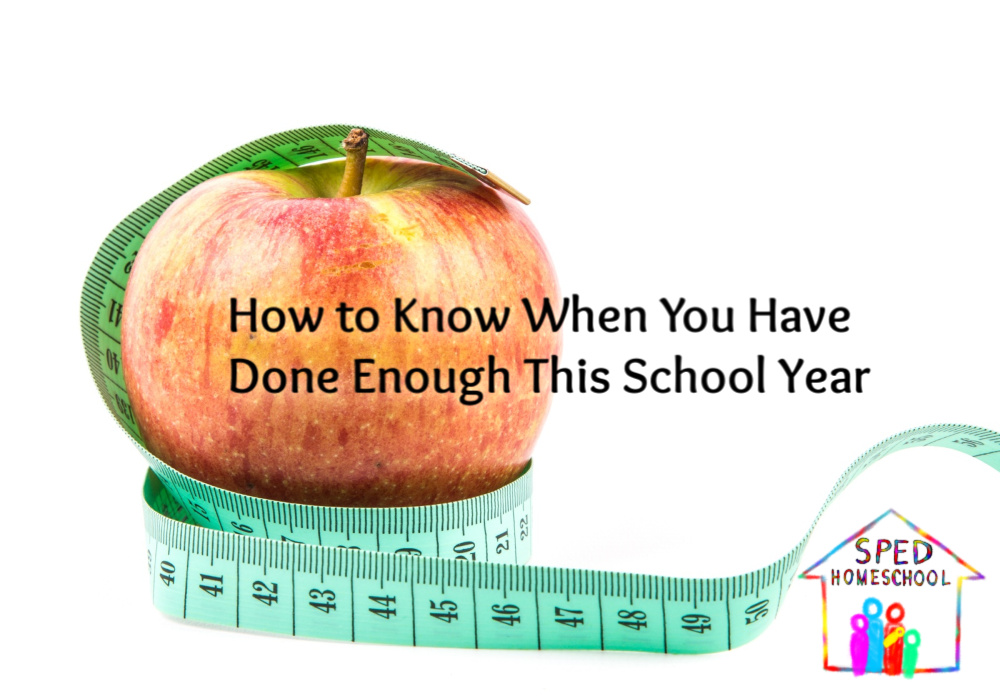
by Shannon Ramiro
This time of year, many of us are wondering how we could have done better this year, how we move forward the rest of this school year, and what to change for next year. The good news is you have plenty of time to figure out what to do next year as well as maximizing the benefits for this year. The bad news? There is none. Wondering if you’ve done enough for your homeschool is very normal, especially for parents of children with special needs.
How to know when you’ve done enough for your homeschool
Did you do any of the following:
- Start the school year choosing one curriculum, or multiple curricula based on what you had been told, or read, would be the best for your child’s identified disabilities?
- Create a study, or learning schedule, and believe you would be able to stick to it on a daily basis?
- Switch gears mid-year, or many times over the year because you answered yes to the first two questions listed here and your plans were not working?
- Want to throw the towel in days, weeks, months into the year because you felt overwhelmed or this year things had become too stressful?
“Wondering if you’ve done enough for your homeschool is very normal, especially for parents of children with special needs.“
All of these things are OK. Keep in mind that learning is a marathon and should be a life-long journey. It is not a sprint with an anxiety ridden parent attempting to cram all the learning their child needs to become an independent, successful adult in before your child turns 18. It is so important to give yourself grace, especially during this time of year. Believe you are doing the best you can with the information you have at all times. Will you look back and wonder what would have happened if you had done “xyz” better? Probably, but again, this is common even for parents of children without disabilities.
Once you’ve accepted that these doubts and feelings of overwhelm are normal, you can actually move on with fresh energy. One of the best ways to combat the doubts of whether you’ve done enough for your homeschool is to allow yourself to reset.
So, how do we reset for the rest of the year?
- If you are homeschooling in a state with little to no regulations, embed creativity into your days. What does your child like to do, or is interested in? Take full advantage of that.
- Loosen up on the schedule. Focus on learning and celebrate small milestones. Any difficulties encountered may, at this stage of the year, be mainly due to fatigue or burnout. Make learning fun again.
- Take the learning outside. With warmer temperatures and sunny days, making the most of learning opportunities out in nature can help negate any attitudes that school is stressful, boring, or too demanding. This is the best time of year to see waterfalls and observe pollination, just to name a couple of learning opportunities rather unique to spring.
- If you must do some sort of testing to fulfill state requirements, practice test-taking strategies (i.e. skipping problems you don’t know, how to make an educated guess, etc.) and learning about the format of the test. Most of all, remind your child that the score given on the test doesn’t really matter. It is only a measure of what they know at a specific point in time.
- Reflect and think about what hasn’t worked and what has worked. Can the things that worked help you identify other curricula or approaches that may fit your child’s needs and learning styles better in the future?
Recognize, or remember, that our children tend to learn things at different times and in different ways. This is why so many all-in-one, or comprehensive curricula do not work for our children. Most of those types of curricula are designed to be accomplished in one year, which is normally considered to be around 180 days, with a full lesson being done every day. However, our children may learn some things rather quickly and need a lot of time learning other things, so the pacing of the curricula doesn’t align well to our planned school calendar.
A huge benefit of homeschooling is that we can customize the learning to what fits our schedule. We can also change things as needed, even if that means we find ourselves tweaking things every other week. Most of all, don’t be so hard on yourself. I believe children naturally want to learn, so letting them lead once in awhile can be extremely beneficial. You might find a new spark along the way that reinvigorates your desire to homeschool and to help increase your confidence that you really can do this!

